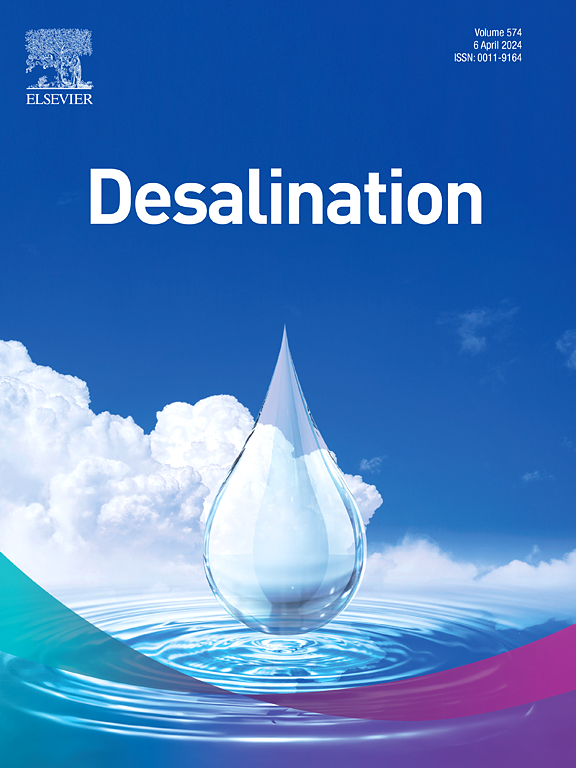十六烷基三甲基溴化铵作为配合剂增强铁基金属有机骨架选择性吸附钨钼的研究
IF 8.3
1区 工程技术
Q1 ENGINEERING, CHEMICAL
引用次数: 0
摘要
钨钼分离一直是钨钼分离的难点和难点。金属有机框架(MOFs)在解决这一问题方面具有很大的潜力。本研究考察了MIL-53(Fe)对W和Mo的吸附和分离性能。此外,本研究引入了一种创新的十六烷基三甲基(CTAB)络合策略,该策略选择性地限制了Mo的吸附,同时提高了MIL-53(Fe)的分离性能。采用仪器分析和计算工具等多种技术,对MIL-53(Fe)的理化性质、吸附分离性能及机理进行了综合表征和分析。在110℃下结晶20 h,成功合成了孔径均匀的MIL-53(Fe)。在中性和碱性条件下,W/Mo的分离系数最高(βW/Mo)为23.93,W的最大吸附量(QW)为547.6 mg/g。CTAB与MoO42−络合后,最大分离因子为37.73,QW = 1272.4 mg/g。该材料在pH 7 ~ 12范围内保持稳定的W吸附量和分离系数。经过5次吸附-解吸循环后,吸附量仍保持在90%以上。结果表明,该材料在资源回收领域作为一种可持续的、生态友好的W、Mo分离吸附剂具有巨大的潜力,其目标是实现W、Mo两种金属的高效、高质量再生。本文章由计算机程序翻译,如有差异,请以英文原文为准。

Highly efficient separation of tungsten and molybdenum by selective adsorption with iron based metal organic framework enhanced by cetyltrimethyl ammonium bromide as complex agent
The separation of tungsten (W) and molybdenum (Mo) has consistently posed a challenge and complexity. Metal-organic frameworks (MOFs) hold great potential for addressing this issue. This research investigated the adsorption and separation performance of MIL-53 (Fe) for W and Mo. Additionally, this study introduced an innovative cetyltrimethyl (CTAB) complexation strategy that selectively restricted Mo adsorption while improving separation performance MIL-53(Fe) was successfully synthesized using a solvothermal method. The physical and chemical properties of MIL-53(Fe), along with its adsorption and separation performance and mechanism, were comprehensively characterized and analyzed using multiple techniques, including instrumental analysis and computational tools. MIL-53(Fe) with a uniform pore size was successfully synthesized by crystallizing for 20 h at 110 °C. This research demonstrated excellent W/Mo separation performance under neutral and alkaline conditions, the highest separation factor (βW/Mo) was 23.93, alongside a maximum adsorption capacity for W (QW) of 547.6 mg/g. After the addition of CTAB complexed with MoO42−, the maximum separation factor has been enhanced to 37.73 with QW = 1272.4 mg/g. This material maintained stable W adsorption capacity and separation factor within the pH range of 7–12. Adsorption capacity remained above 90 % after five adsorption-desorption cycles. It was found that the mechanism involved the electrostatic attraction, and the Fe metal sites exhibited a stronger affinity for W. This material demonstrates significant potential as a sustainable and eco-friendly adsorbent for the separation of W and Mo in the field of resource recovery, targeting the efficient and high-quality regeneration of both metals.
求助全文
通过发布文献求助,成功后即可免费获取论文全文。
去求助
来源期刊

Desalination
工程技术-工程:化工
CiteScore
14.60
自引率
20.20%
发文量
619
审稿时长
41 days
期刊介绍:
Desalination is a scholarly journal that focuses on the field of desalination materials, processes, and associated technologies. It encompasses a wide range of disciplines and aims to publish exceptional papers in this area.
The journal invites submissions that explicitly revolve around water desalting and its applications to various sources such as seawater, groundwater, and wastewater. It particularly encourages research on diverse desalination methods including thermal, membrane, sorption, and hybrid processes.
By providing a platform for innovative studies, Desalination aims to advance the understanding and development of desalination technologies, promoting sustainable solutions for water scarcity challenges.
 求助内容:
求助内容: 应助结果提醒方式:
应助结果提醒方式:


